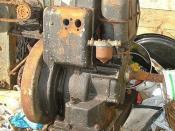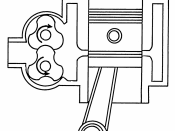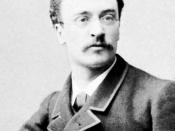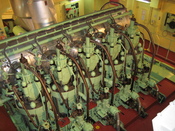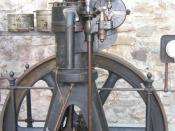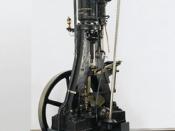Rudolf Diesel was born on March 18, 1858 in Paris and was the son of a leather merchant. He died on September 29, 1913 while crossing the English Channel.
Rudolf Diesel studied in England and at the Polytechnic School in Munich where he then settled. He began his career as a refrigerator engineer. Diesel also worked from 1893-1897 at the Augsburg Machine-Works developing a working engine. He worked for ten years on various heat engines. Diesel worked himself into a nervous breakdown promoting the not-yet-ready engine. Diesel was also a connoisseur of the arts, a linguist, and a social theorist. In 1893 Rudolf Diesel published a paper entitled "The Theory and Construction of a Rational Heat Engine,"ÃÂ in which he described an engine in which air is compressed by a piston to a very high pressure, causing a high temperature. Fuel is then injected and ignited by the compression temperature.
Diesel set up his first shop-laboratory in Paris and began his 13-year ordeal of creating his own engine. Diesel built his first engine on August 10, 1893 and patented it within a few years. Diesel prime model was a single 10-foot iron cylinder with a flywheel at its base. Diesel then spent two more years improving his invention. Diesel's design became the standard of the world for that type of engine and his name was attached to it.
Diesel thought that the United States was the greatest place to market his engines. The first diesel built in the United States was made in 1898 by the Busch-Zulzer Brothers Diesel Engine Co. The president of that company was Adolphus Busch of Budweiser brewing fame who had purchased the North American Manufacturing rights.
On New Year's Eve in 1896 Diesel proudly displayed an engine that he had built that had a efficiency of 75.6 percent. There was nothing equal to this to the date in thermodynamic engines.
Industries quickly began to use Diesel's engines and Diesel became a millionaire from the royalties and franchise fees. His first engines were use in stationary machines then in ships in 1903. They were used in French submarines in 1904. In 1906 they were used in power plants and in a Diesel truck. It was not accepted into vehicle manufacturing until the 1920's. It was first used in larger utility vehicles.
In1930 public transportation used the diesel engines in their public buses. It was not until 1930 that diesel engines were used in passenger cars and the exhibition was in Berlin. It was considered a low performance car and used only as a second choice to the gasoline car. In 1973 and 1974 when the first oil crises occurred that the diesel engine became more popular in the automobile market.
Diesel expected to power his engines with vegetable oils (including hemp) and seed oils. In the 1900's at the World's Fair, Diesel ran his engines on peanut oil.
The first diesel-electric locomotive was used by the Central Railroad of New Jersey for switching operations in New York City in the mid 1920's. By the mid 1930's the Burlington and the Union Pacific both used diesel power for their new streamliner passenger trains and in 1941 the Santa Fe used diesel power for freight service.
Diesel had many challenges while trying to make the perfect engine. He tried to raise the temperature of pure air to very high degree through vigorous compressions. At this high temperature when the piston was beginning to descend, fuel would be introduced at just the right time. The first prototype engine built in 1983 was not functional. The second prototype engine built in the summer of 1894 had and efficency of 16.6%. Towards the end of 1896 and the beginning of 1897 the third prototype engine became functional. It was called the Augsburg engine also known as the first Diesel engine.
The death of Rudolf Diesel is somewhat a mystery. Diesel was a man that was taunted by many people who criticized him for his role in creating the engine. In 1913 he vanished from a boat while crossing the English Channel on the mail steamer Dresden from Antwerp to Harwich. Many people think that it was accidental or an assassination. Others think that it was suicide because they say that he was about to sell secrets to the British. Some say he was despondent and suffering form some form of depression. Most historians think that he most likely committed suicide. Diesel had some sort of mental breakdown while he was working to develop the engine. He had to be put in a hospital and never really got control of his life and that is why they think that it was suicide. His body was found 10 days later.
Shortly after the death of Diesel a diesel-powered German submarine fleet became scourge of the sea. Diesel had been friendly to France, Britain and the United States of America.
Work Cited www.uh.edu/engines/epl1435.html www.energy.ca.gov/education/scientists/diesel.html www.euro-auto-hall.org/inductees/diesel.html www.invent.org/book/book-text.31.html www.bergen.org/aast/projects/timeline/transportation19/diesel.html www.hempcar.org/diesel.shtml http://world.std.com/~jtr/doom/diesel/html www.germanembassy-india.org/news/june97/76gn16/html
